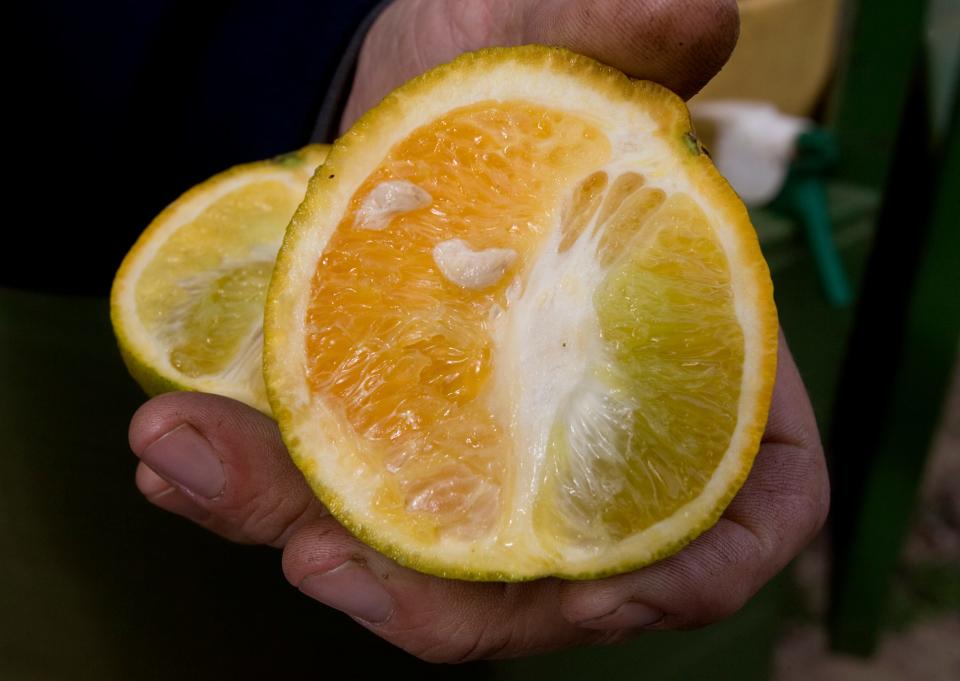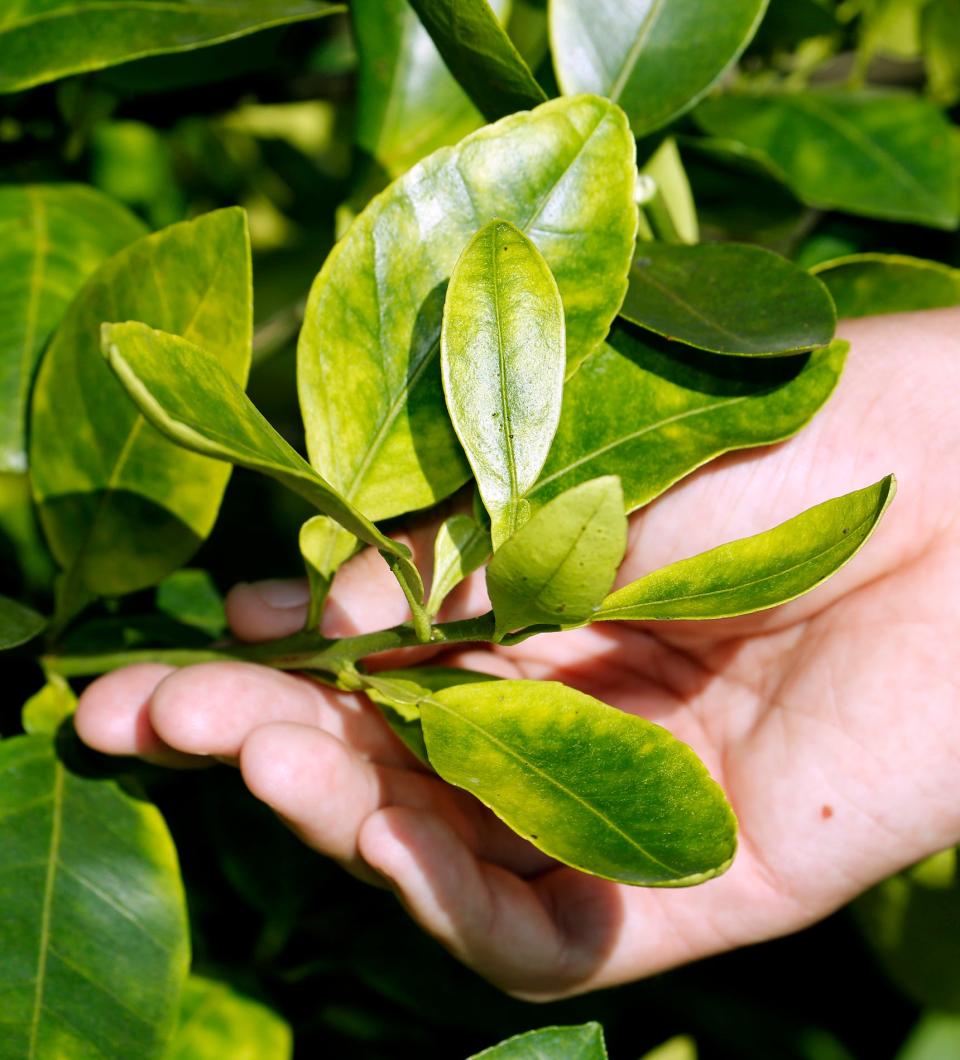New research to combat citrus greening plants seeds of optimism among Florida growers
LAKELAND – As a revised citrus forecast predicts an even smaller crop for the 2020-2021 growing season than first expected, researchers offered hope Tuesday to growers on a field tour.
On Dec. 9, the U.S. Department of Agriculture projected production of Florida oranges at 46 million boxes and Florida Grapefruit at 4.1 million boxes for the 2021-22 citrus season in its December forecast.
The forecast is a decrease from the initial benchmark October prediction for Florida orange production, explained a press release from Shannon Shepp, Executive Director of the Florida Department of Citrus.

On a positive note, production projections for Florida grapefruit increased while specialty fruit remained the same.
The December forecast update "underscores why support from leadership and policymakers is so important," Shepp said. "This is an industry that continues to fight and remains a vital component of the state’s economy.”
Citrus outlook: USDA citrus forecast predicts 11% fewer Florida oranges and 8% fewer grapefruits this season
Related: Researchers share latest tactics with citrus growers in fight against greening
More: Citrus World growers cooperative reports higher sales than last year
The industry blames citrus greening or HLB for reduced fruit size, increased fruit drop and less desirable fruit shape and taste.
The disease reached Florida in 2005 and within three years, had spread to the majority of citrus farms.
A seasonal benchmark, the October USDA citrus forecast had predicted 11% fewer Florida oranges and 8% fewer grapefruits this season before revising its forecast downward in December.
The peak of citrus production was 244 million boxes during the 1997-98 season.
Bill Curtis, agricultural statistics administrator with the Florida Department of Agriculture and Consumer Services, said in October that “the fruit per tree is the lowest on record for both Florida non-Valencias and Valencias since records were kept during the 1964-65 crop.
On Tuesday, about 71 growers had registered to learn more about recent citrus field trials on nutrition and gibberellic acid and their impact on HLB-infected trees. Researchers at University of Florida's Institute of Food and Agricultural Sciences gave presentations during morning tours at Fort Meade-based Peace River Packing Company groves.
The event began at the Stuart Conference Center in Bartow before participants drove to the groves. The field day was hosted by UF/IFAS Extension citrus agent Chris Oswalt and researchers Tripti Vashisth and Amit Levy, from the Citrus Research and Education Center located in Lake Alfred.
The mission of the University of Florida Institute of Food and Agricultural Sciences is to develop knowledge relevant to agricultural, human and natural resources and to make that knowledge available to sustain and enhance the quality of human life.
UF/IFAS has more than a dozen research facilities, 67 county extension offices, and award-winning students and faculty in the UF College of Agricultural and Life Sciences.
At the nutrition field site, Vashisth discussed the results of a multi-year citrus nutrition field trial with growers that was designed to provide an effective grove management plan for HLB-infected trees.
Fighting citrus disease: Researchers to study using microbes to combat citrus canker

The results of the trial indicate that HLB can be managed to some degree in the field using mineral nutrition, including manganese, Iron and zinc, among others. She also explained that soil Ph of 5.8 is best as too much acid can harm trees and make them less able to produce in the era of HLB.
Overall, Vashisth said, "Our nutrition trial block looks very good, it has HLB for more than 10 years and has been producing above average for last 6 years,"
Levy explained at the grove along J Jackson and Lake Hendry roads that canopy density can be measured with a $30 light meter at ground level - a measure that helps growers evaluate the effectiveness of their nutritional treatments as they manage HLB groves.
If the sun passes through the tree and the light meter shows more than 10-15% of sunlight coming through the tree's canopy of leaves, then an HLB infected tree may be unable to produce the desired citrus.
When 90% of sunlight is absorbed by the tree's leaves, a term he called, 'interception of light," the fruit yield is higher, drop is less and taste is better. He added, "more canopy for more fruit."
At the gibberellic acid field trial a mile away, growers saw for themselves two rows within a grove of treated and non-treated trees. Vashisth gave a presentation about the timely use gibberellic acid sprays to manage citrus flowering and reduce tree stress.
Also: Mexican imports continue to hurt U.S. tomato prices, new report shows
Early indications showed that gibberellic acid-treated trees could better withstand stress as compared to untreated trees, in terms of fruit and leaf drop. The less flowers the more the tree can grow fruit and roots, she explained.
Grove owner Larry Black noted that "the data coming from IFAS is encouraging. They're delivering solutions for HLB to allow citrus to thrive."
Florida Citrus Mutual's incoming executive director and CEO, Matthew Joyner, also attended the tour on grove management research.
"We're seeing some interesting stuff. It's still not a silver bullet yet," he said, adding more work is needed - including the timing of spraying nutrients and the gibberellic acid.
Joyner, however, was optimistic for the citrus industry - noting that many trees have been planted since 2017 in the decades following several hurricanes that passed through the growing region of Florida.
Moving on: Florida Citrus Mutual's Michael Sparks to retire, remains optimistic about industry's future
Florida Citrus Mutual is the industry trade group that lobbies in Tallahassee and Washington, D.C. for funding for research. The group claims a membership of 3,000 growers, and was established in 1948.
The group fought for the CRAFT program to be funded, which was designed to work as a cooperative effort between growers and researchers to develop economically feasible production management practices and programs for Florida growers to utilize in the era of HLB.
Paul Nutcher covers business and industry for The Ledger. He can be reached at pnutcher@gannett.com.
This article originally appeared on The Ledger: Citrus greening: UF presents research in fight against crop disease

